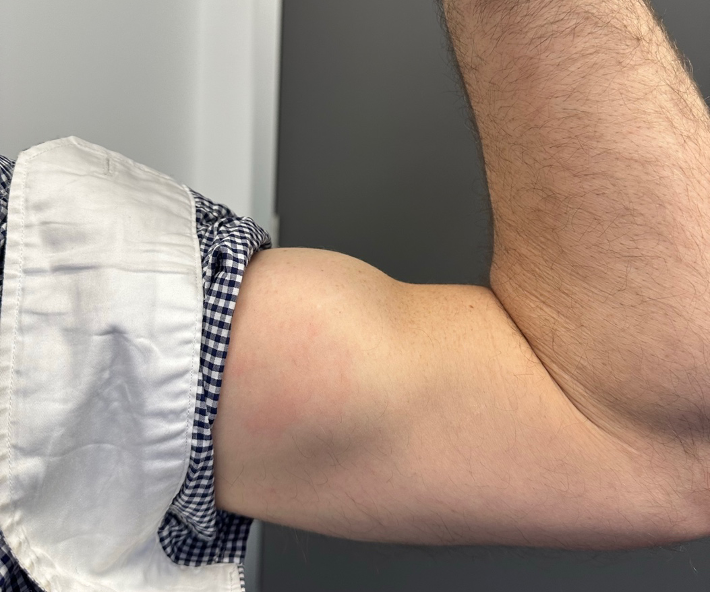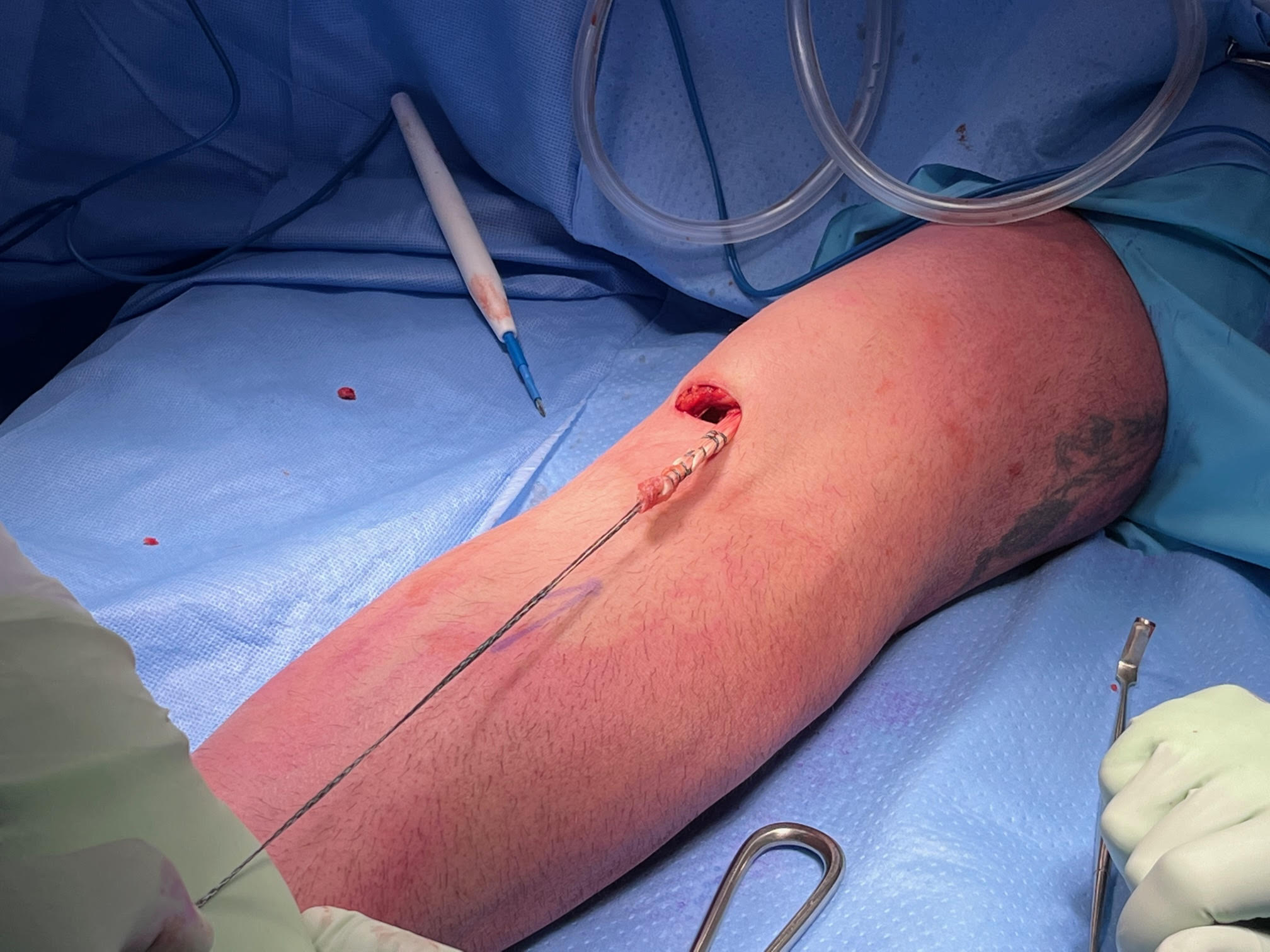Distal Biceps Ruptures
Quality Orthopaedic Care in Adelaide by
Dr Oscar Brumby-Rendell
A distal biceps tendon rupture is a tear of the tendon that connects the biceps muscle to the radius bone near the elbow. This injury often occurs suddenly during forceful lifting or pulling and can lead to a significant loss of strength, especially in forearm rotation (supination) and elbow flexion.
Dr Oscar Brumby-Rendell, a fellowship-trained orthopaedic shoulder and upper limb surgeon in Adelaide, specialises in the diagnosis and surgical treatment of distal biceps ruptures, helping patients regain strength, function, and confidence after injury.
What is a Distal Biceps Rupture?
The distal biceps tendon attaches the biceps muscle to the forearm. When this tendon ruptures,typically due to a sudden, forceful load while the elbow is bent, it may retract into the upper arm, leaving the biceps muscle visibly deformed and functionally weakened.
This condition is far less common than proximal (shoulder-side) biceps tears and usually affects middle-aged men involved in manual work, weightlifting, or athletic activity.

Common Causes of Distal Bicep Rupture
Several factors contribute to the development of distal biceps ruptures. These may include:
- Acute trauma: A sudden and forceful contraction of the biceps muscle, often while the elbow is forcefully straightened against resistance, can lead to a distal biceps rupture.
- Chronic degeneration: Over time, the biceps tendon may undergo degenerative changes, becoming weakened and more susceptible to rupture with repetitive activities or age-related wear and tear.
- Anatomical factors: Certain anatomical variations, such as a shallow bicipital tuberosity or abnormal tendon insertion, can increase the risk of distal biceps ruptures.
Risk factors include:
-
Middle-aged men (40–60 years old)
-
Smoking (which weakens tendon integrity)
-
Use of anabolic steroids
-
Repetitive strain or overuse
Symptoms
The symptoms of a distal biceps rupture may include:
- Sudden pain: Sharp and immediate pain at the front of the elbow or forearm at the time of injury.
- Audible “pop” or snap: Some individuals hear or feel a popping or snapping sensation at the time of the injury.
- Visible deformity: The biceps muscle may appear to “ball up” or “bunch up” near the elbow due to the retraction of the torn tendon. (See photo of “Popeye” sign.)
- Weakness and functional loss: Difficulty with forearm supination (turning the palm upward) and decreased strength in elbow flexion (bending the elbow against resistance).
Prompt medical assessment is essential to confirm the diagnosis and determine the appropriate treatment approach.
How is a Distal Biceps Rupture Diagnosed?
Dr Oscar Brumby-Rendell performs a thorough clinical evaluation, including:
-
Physical examination, focusing on strength, deformity, and range of motion
-
Hook test to assess tendon attachment
-
Ultrasound or MRI to confirm the tear and evaluate the degree of retraction
Early diagnosis is critical: To get the best success with your surgical repair you'll need to have them within the first 2-3 weeks after your injury.
Treatment for Distal Biceps Rupture
Non-operative treatment
Non-operative treatment may be considered for individuals with certain lifestyle and activity demands, medical comorbidities, or in cases where surgery is contraindicated. However, it is important to note that non-operative treatment typically results in a significant loss of forearm supination and elbow flexion strength.
Rest and immobilisation: Initially, a period of rest and immobilisation using a splint or brace is recommended to protect the injured tendon.

Physical therapy: Once the acute phase has passed, a physical therapy program may be initiated to improve range of motion, strength, and functional abilities of the affected arm. However, it is important to note that even with physical therapy, there may be a significant loss of forearm supination (up to 50%) and elbow flexion strength (up to 30%).
Operative treatment
Operative treatment is often recommended for individuals who desire to restore strength and function, particularly for those involved in physically demanding activities. Surgical repair or reattachment of the distal biceps tendon can be performed.
Non-Surgical Management
In rare cases, non-operative treatment may be appropriate, particularly for:
-
Low-demand or elderly patients
-
Partial tears
-
Those unwilling or unable to undergo surgery
However, non-surgical care typically results in reduced strength, especially for forearm rotation and heavy lifting tasks.
Surgical repair: The torn or detached distal biceps tendon is reattached to the bone using various techniques, such as transosseous tunnels with tensionable buttons or suture anchors. This restores the continuity of the tendon and allows for proper healing.

Operative treatment
Rehabilitation: Following surgery, a comprehensive rehabilitation program is crucial to optimise recovery. Physical therapy exercises are initiated to regain range of motion, strength, and functional abilities of the affected arm. The first 6 weeks will concentrate on regaining full elbow range of motion. The next 6 weeks (weeks 6-12 post-surgery) will gradually increase the load to rebuild the strength of the biceps. From 12 weeks post-surgery, patients will typically be cleared for full lifting as tolerated. Patients will be advised not to lift anything over half a kilogram for the first 6 weeks to allow the tendon to heal back onto the bone.
It is important to consult with a healthcare professional to determine the most appropriate treatment approach based on individual factors, severity of the injury, and patient goals.
Frequently Asked Questions
Delaying treatment can lead to increased tendon retraction (the tendon pulls further away from its original attachment), which makes surgical repair technically harder and may reduce the strength recovery. Over time, scar tissue may form, muscles may atrophy, and the ability to restore full forearm rotation (supination) can be compromised.
Why Choose Dr Oscar Brumby-Rendell for Biceps Tendon Repair?
With specialised training in upper limb surgery and minimally invasive tendon repair techniques, Dr Brumby-Rendell provides comprehensive care for patients with distal biceps tendon ruptures. His treatment plans are designed around each patient's goals, activity level, and timeline for recovery.
What patients can expect:
-
Timely diagnosis and expert evaluation
-
Advanced surgical techniques with proven outcomes
-
Personalised rehabilitation planning
-
Supportive, one-on-one patient care

Ready to learn more?
Watch more of our shoulder-related videos hosted by Dr Oscar Brumby-Rendell.
Read more about elbow-related injuries here:
Once you have a referral…
Book your consultation here.
